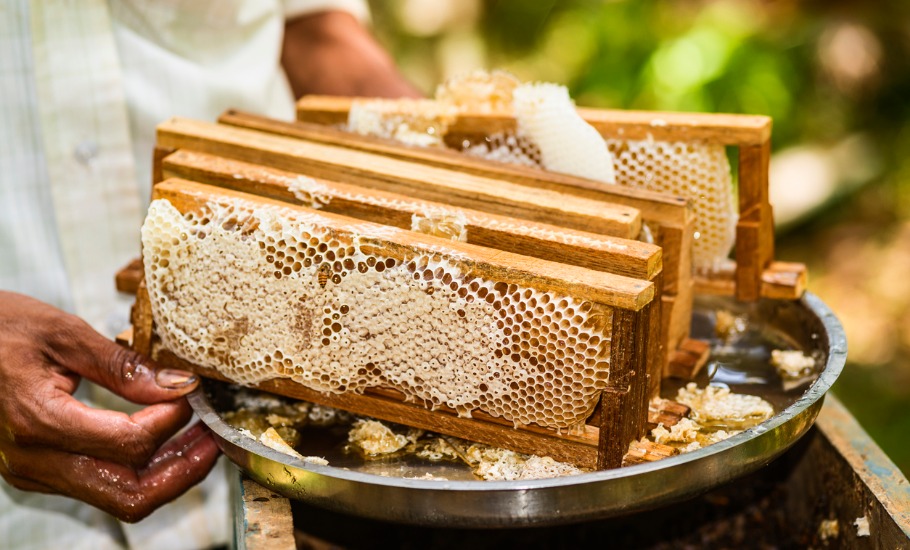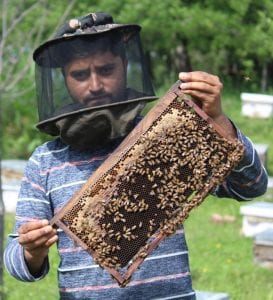
Beekeepers want training as govt allocates ₹500 crore for apiculture
The Centre's allocation of ₹500 crore for apiculture, or beekeeping, as part of its financial stimulus package is expected to boost bee farming across the country, and beekeepers say that this fund can be used to provide hands-on training to farmers to make the sector more profitable.

The Centre’s allocation of ₹500 crore for apiculture, or beekeeping, as part of its financial stimulus package is expected to boost bee farming across the country, and beekeepers say that this fund can be used to provide hands-on training to farmers to make the sector more profitable.
Union Finance Minister Nirmala Sitharaman had unveiled the scheme during the third tranche of announcements of the package, and said it will benefit nearly two lakh beekeepers.
Apiculture is one of the profitable sectors under agriculture which involves farmers who exclusively focus on bee farming, as well as others who take it up along with their regular agricultural works. The Centre has often come up with various schemes like Honey Mission to promote beekeeping.
Related news: Tamil Nadu faces another outbreak with shortage of cattle feed, exposed vets
In the year 1994-95, during the eighth Five Year Plan, the Centre had created a dedicated National Bee Board (NBB) under the Ministry of Agriculture, aimed at encouraging beekeeping to improve crop production. It also concentrates on honey production.
According to NBB data, in 2017-2018, India’s honey production had increased to 1.05 lakh metric tonnes, compared to 35,000 tonnes in 2005-2006. The country’s honey has found markets in Germany, Italy, France, Spain, US, UK and Japan. In 2019, India had exported honey worth $99.6 million and export forecasts say that the demand for Indian honey may increase in coming years.
Bees, friends of farmers
There are five types of honeybees that exist in India. Except the Italian bee (Apis mellifera), the other four are found naturally in the surroundings. Among these, the Italian bee, the Indian bee (Apis cerana indica) and the stingless bee (Trigona) are useful in apiculture. These are the only honeybees that can be reared in boxes.
If beekeeping has to be taken up commercially, a beekeeper will need at least 100 boxes. For a regular farmer, five to six bee boxes per acre are enough to increase the farm’s productivity, according to N.V. Mahadevan, a Coimbatore-based beekeeper.
“Suppose if in a farm, 100 cucumbers is the normal yield from one plant, the productivity can be increased to 200 cucumbers by keeping a bee box in the same farm; an increase of 100 per cent. This is because bees pollinate flowers at the right time, automatically increasing fruit formation. Such is the extent that bees help in pollination,” he said.
Related news: COVID-19: Birders ‘challenge’ lockdown to study about bird calls
In Tamil Nadu, there are about 40,000 beekeepers who are mostly trained by agricultural colleges, said entomologist K. Suresh, Department of Entomology, Agricultural College and Research Institute, Madurai. The college provides one-day training to beekeepers on the 15th of every month at a charge of ₹600.
“In places like Marthandam in Kanyakumari district, villagers keep bee boxes in their houses, just like growing a tree in each house,” he said.
Besides honey, there are several by-products like wax, royal jelly, propolis and bee pollens that can be collected from bee boxes that are mostly used in cosmetics and pharma industries. Bees are also used in venom therapy, said Suresh. “Those by-products will fetch an additional income for the beekeepers,” he said.
Beekeeping in the time of COVID-19
“Due to less human activity, the bee population has increased significantly during this lockdown,” said Suresh. However, like any other business, COVID-19 certainly had an impact on apiculture too.
Venice, a beekeeper and a member of the Marthandam Bee Keepers Cooperative Society, said it is difficult to bring honey that has been collected in states like Kerala and Karnataka, due to the ongoing lockdown.

“This is the only society for beekeepers in south India. We collect honey not only from Tamil Nadu beekeepers, but also from those in Kerala and Karnataka. Particularly Kerala, which is near to Kanyakumari, has nearly 300 families who actively engage in apiculture. There are about 2.5 lakh bee boxes there. Close to 50,000 boxes are located in Karnataka,” he said.
The society has about 1,500 member beekeepers. It can store up to 3 lakh kg of honey and up to 2 lakh kg is yet to arrive from Kerala and Karnataka, said Venice. “February to April is the season for collecting honey. Not many beekeepers have the facility to store honey that they have collected. If cross-border transportation is eased, it will benefit the beekeepers in other states,” he added.
How funds must be utilised
The Centre has said the allocation of ₹500 crore will benefit two lakh beekeepers. This amounts to ₹25,000 assistance for a beekeeper. Using this fund, a lot can be done such as providing training, distributing bee boxes, etc, said Mahadevan.
“Many state governments distribute beekeeping boxes along with bees to the farmers. But most of the farmers lack hands-on training in beekeeping. If the governments come forward to train people in beekeeping, it will be even more profitable,” he said.
Agreeing to his view, Suresh said though bee boxes are provided with subsidies under the National Horticulture Mission and National Agriculture Development Programme, due to the lack of training, farmers leave their bee boxes in lurch. The farmers should check the bee boxes once in 15 days. The boxes should be saved from rain and ants. Large-scale commercial beekeeping, say 100 boxes, needs at least five labourers.
“Maintaining of bee boxes requires minimal work. But most of the farmers fear of bee bites. Once they are given proper training, they will actively engage in apiculture. The training will also help them get loans from the Khadi and Village Industries Commission,” said Suresh.
Meanwhile, Venice stressed the funds should be distributed through cooperative societies.
Threats and adulteration
According to Suresh, the indiscriminate use of insecticides is the biggest threat for bees than climate change. Echoing his view, Mahadevan said 90 per cent of farmers use insecticides or weed killers without knowing that those chemicals can inflict more harm to these industrious honeybees.
Adulteration is another major problem in honey production. Among the Italian bee and Indian bee, the former is reared mostly in north India due to the weather and the flora.
“It prefers a cooler climate. Between 20 to 30 kgs of honey per colony can be harvested. In a year, harvest can be done twice: in March-April or September-October. The Indian bee, gives 4 to 6 kgs of honey per colony,” said Mahadevan.
Related news: It’s more than 21 days for fishers as ban on venturing into sea nears
Attracted by the amount of honey, many beekeepers in south India are starting to grow Italian bee. But the weather conditions are not fully suitable.
“To ensure bees stay healthy during hot summers or monsoon, commercial beekeepers add antibiotics in the sugar syrup or honey feed. That ends up as residues in the honey. Many European countries have strict guidelines on the amount of contaminants in the honey, and countries like Germany have many times banned imports of such honey,” said Mahadevan.
It is important to train beekeepers regarding these, systematically. Luckily, India is naturally bio-diverse, but we risk losing these flying angels with continued use of insecticides, weed killers or genetically modified crops.


